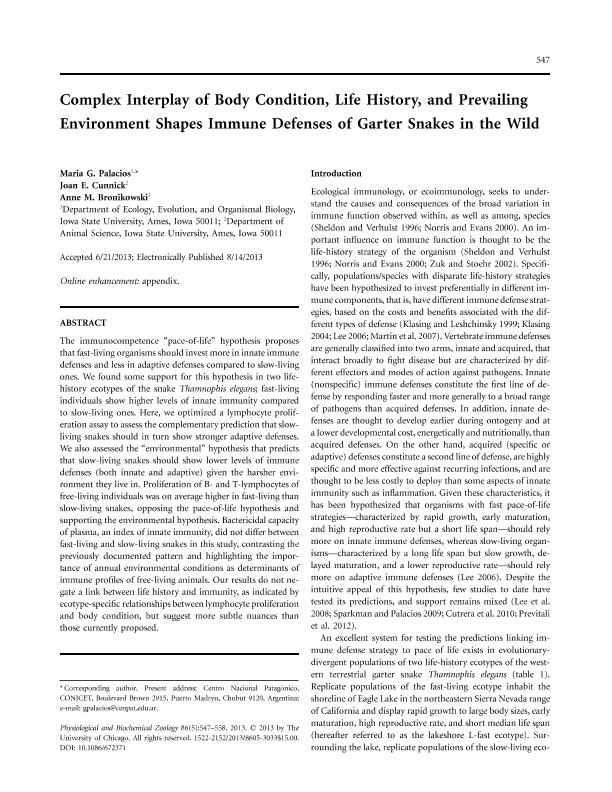Artículo
Complex interplay of body condition, life history, and prevailing environment shapes immune defenses of garter snakes in the wild
Fecha de publicación:
09/2013
Editorial:
University of Chicago Press
Revista:
Physiological and Biochemical Zoology
ISSN:
1522-2152
Idioma:
Inglés
Tipo de recurso:
Artículo publicado
Clasificación temática:
Resumen
The immunocompetence "pace-of-life" hypothesis proposes that fast-living organisms should invest more in innate immune defenses and less in adaptive defenses compared to slow-living ones. We found some support for this hypothesis in two lifehistory ecotypes of the snake Thamnophis elegans; fast-living individuals show higher levels of innate immunity compared to slow-living ones. Here, we optimized a lymphocyte proliferation assay to assess the complementary prediction that slowliving snakes should in turn show stronger adaptive defenses. We also assessed the "environmental" hypothesis that predicts that slow-living snakes should show lower levels of immune defenses (both innate and adaptive) given the harsher environment they live in. Proliferation of B- and T-lymphocytes of free-living individuals was on average higher in fast-living than slow-living snakes, opposing the pace-of-life hypothesis and supporting the environmental hypothesis. Bactericidal capacity of plasma, an index of innate immunity, did not differ between fast-living and slow-living snakes in this study, contrasting the previously documented pattern and highlighting the importance of annual environmental conditions as determinants of immune profiles of free-living animals. Our results do not negate a link between life history and immunity, as indicated by ecotype-specific relationships between lymphocyte proliferation and body condition, but suggest more subtle nuances than those currently proposed.
Palabras clave:
Adaptive Immunity
,
Bacterial Killing
,
Ecological Immunology
,
Reptile
Archivos asociados
Licencia
Identificadores
Colecciones
Articulos(CCT-CENPAT)
Articulos de CTRO.CIENTIFICO TECNOL.CONICET - CENPAT
Articulos de CTRO.CIENTIFICO TECNOL.CONICET - CENPAT
Citación
Palacios, Maria Gabriela; Cunnick, Joan E.; Bronikowski, Anne M.; Complex interplay of body condition, life history, and prevailing environment shapes immune defenses of garter snakes in the wild; University of Chicago Press; Physiological and Biochemical Zoology; 86; 5; 9-2013; 547-558
Compartir
Altmétricas




